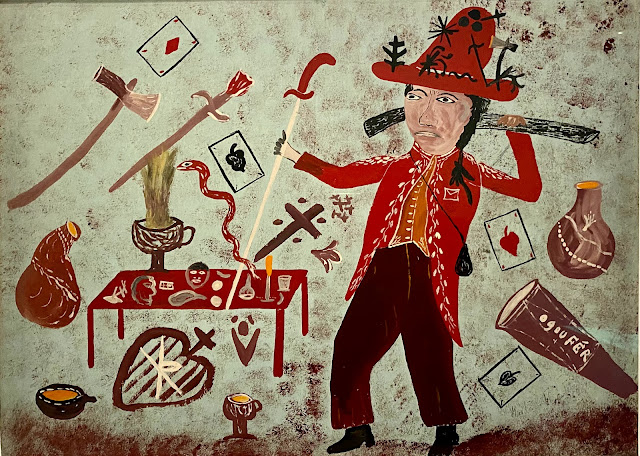You'll find more than the usual suspects in "Beyond Surrealism" at the Metropolitan Museum of Art. Although Magritte and Dali are there, too.
 |
| "Time Transfixed" by Rene Magritte (1938) |
 |
| "Soft Construction with Boiled Beans/Premonition of Civil War" by Salvador Dali (1936) |
Artists whose work I'd never seen before comprise the bulk of the show. Unlike most Surrealists, Ocampo, a Filipino revolutionary, didn't shy away from Catholic imagery as a way to protest American colonialism after World War II.
 |
| "Glooming" by Hernando R. Ocampo (1939-1949) |
These works, sculpted mostly from found materials, photographed much better than Dali's iconic "Lobster Telephone."
 |
| "The Last Voyage of Captain Cook" by Roland Penrose (1936-37) |
 |
| "Angel of Anarchy" by Eileen Agar (1936-1940) |
 |
| "Incognito Heart" by Ladislav Zivr (1936) |
Andre Breton, the French godfather of Surrealism, wrote that "Haitian painting will drink the blood of the phoenix. And, with the epaulets of [Haitian revolutionary leader Jean-Jacques] Dessalines, it will ventilate the world." That sounds a little bit like mansplaining, particularly because Hyppolite didn't consider himself a Surrealist.
 |
| "Ogu Feray" by Hector Hyppolite (ca 1945) |
"At Land," directed by Maya Deren, a Ukrainian, alludes to the change in consciousness that can occur during travel or, more negatively, among refugees.
New Zealand-born Len Lye reflects indigenous Oceanic art in the drawings that he animated for "Tusalava" (1929).
A redhead gazes at Pierre Alechinsky's bird's-eye view of "Central Park" (1965). Pretty meta, given the museum's location.
Materials were hard to come by in Romania during World War II so Brauner learned to use encaustic, or wax. He created this post-war work in Paris, which combines ancient, occult and indigenous symbols, the same way.
 |
| "Prelude to a Civilization" by Victor Brauner (1954) |
This painting embeds the exiled Carrington and her husband, who fled Paris to Mexico during the Nazi occupation, in almost grotesque surroundings that recall Hieronymus Bosch.
 |
| "Chiki, Your Country" by Leonora Carrington (1944) |
Jan Svankmajer took advantage of the very brief Prague Spring to film "The Flat" (1968) which employs Charlie Chaplin-like slapstick to expose the absurdity of everyday life under a totalitarian regime.
I mostly associated Surrealism with the early 20th century, a notion dispelled by the curators who introduced me to Ted Joans, my favorite discovery of the show. A musician himself, he once roomed with Charlie Parker.
 |
| "Bird Lives" (1958) |
Joans, who twice fled America's racism after his 1928 birth in the Midwest, wrote "Jazz is my religion, Surrealism is my point of view." His style is hard to pin down. The Hipsters (1961) chronicles life in Greenwich Village, "the home of the hipster, hipnick, flip, flipnick, etc., where several thousand top people of all races, creeds and colors work, play, and love in sometimes peace and sometimes harmony and all try to enjoy the the lofty fruit of US d e m o c r a c y." The brutal murder by police of Amadou Diallo, a young black man in the Bronx, forced Joans into exile a final time.
Surrealists were for the most part a collaborative group and no work captures their spirit better than the 30 feet of "Long Distance," known as a cadaver exquis or exquisite corpse. During a 32-year period beginning in 1976, Joans, traveling all over the world, collected drawings from 132 people, including Paul Bowles, Allen Ginsberg, Amiri Baraka, Taylor Mead and Octavio Paz. Joans died two years before its completion in 2005, but Surrealism lives!



No comments:
Post a Comment